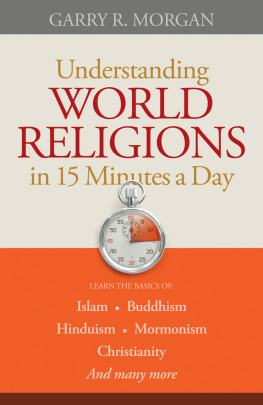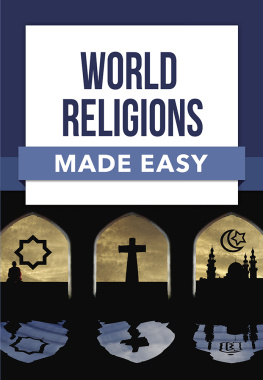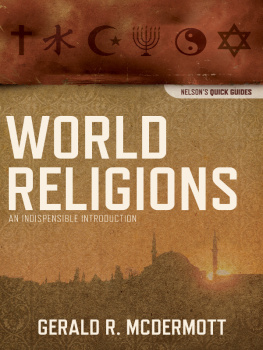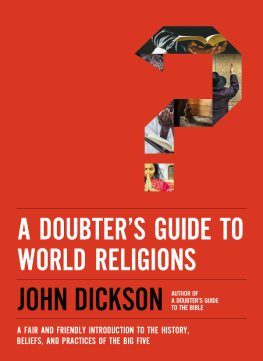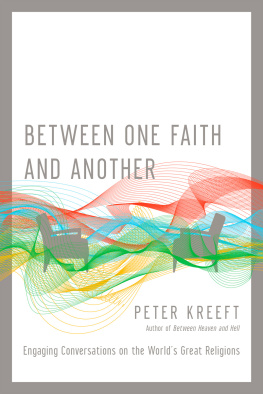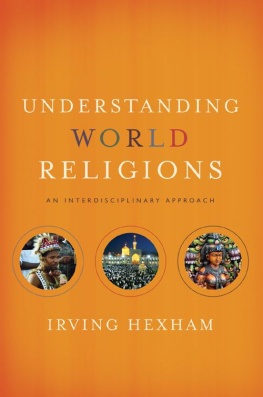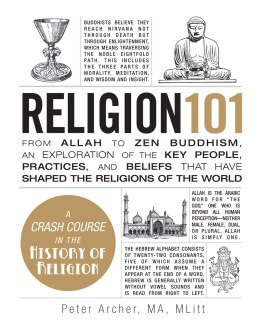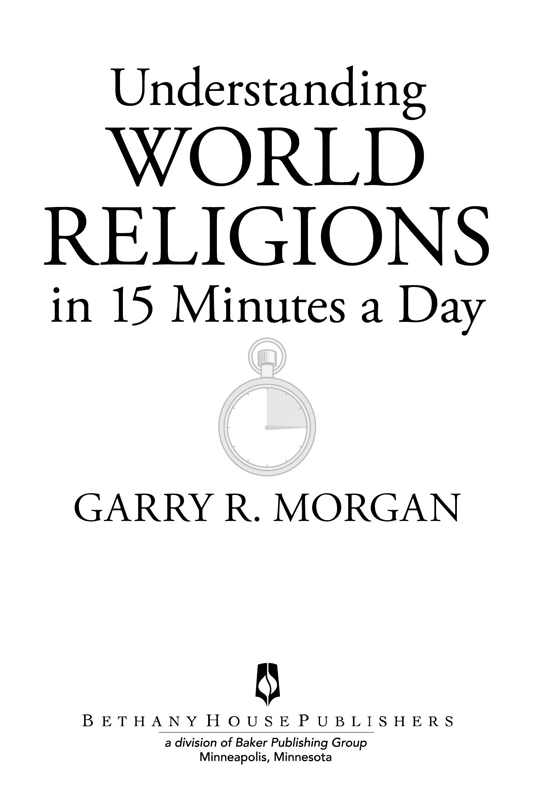
2012 by Garry R. Morgan
Published by Bethany House Publishers
11400 Hampshire Avenue South
Bloomington, Minnesota 55438
www.bethanyhouse.com
Bethany House Publishers is a division of
Baker Publishing Group, Grand Rapids, Michigan
www.bakerpublishinggroup.com
Ebook edition created 2012
All rights reserved. No part of this publication may be reproduced, stored in a retrieval system, or transmitted in any form or by any meansfor example, electronic, photocopy, recordingwithout the prior written permission of the publisher. The only exception is brief quotations in printed reviews.
ISBN 978-1-4412-5988-2
Library of Congress Cataloging-in-Publication Data is on file at the Library of Congress, Washington, DC.
Scripture quotations are from the New American Standard Bible, copyright 1960, 1962, 1963, 1968, 1971, 1972, 1973, 1975, 1977, 1995 by The Lockman Foundation. Used by permission.
Cover design by Eric Walljasper

Preface
Acknowledgments
1. What Is Religion?
2. Why Learn About Other Religions?
3. Christianity: What Sets It Apart?
4. Roman Catholic Christianity
5. Eastern Orthodox Christianity
6. Protestant Christianity
7. Evangelical Christianity
8. Animism and Folk Religions
9. Native American Religions
10. African Traditional Religions
11. Judaism: Historical Development
12. Judaism: Today
13. Zoroastrianism
14. Islam: Beginnings
15. Islam: Foundations
16. Islam: Beliefs
17. Islam: Theology
18. Islam: Varieties and Issues
19. The Nation of Islam
20. Bahai
21. Hinduism: Origins
22. Hinduism: Beliefs and Practices
23. Hinduism: Today
24. Jainism
25. Sikhism
26. Theravada Buddhism
27. Mahayana Buddhism
28. Tibetan Buddhism
29. Confucianism
30. Taoism
31. Shinto
32. Secular Humanism
33. Cults, Isms, and Contemporary Religious Movements
34. The Unitarian-Universalist Association, The Unity School of Christianity, and The Unification Church
35. Christian Science and Scientology
36. Mormonism
37. Jehovahs Witnesses
38. Neopagan Religions
39. New Age Religions
40. Transcendental Meditation

T oday nearly six billion people profess some form of religion. Not only is there tremendous variety of religious beliefs, within any given religion there are disparities in some beliefs and practices. Add to this the cultural variations that impact any religion practiced in multiple parts of the world and a kaleidoscope of differences emerges.
The migration patterns of recent decades (over one billion people on the move since 1970) have brought previously isolated religious groups into contact with followers of other religions, or into new settings that have compelled some alteration of practices, resulting in even more changes. (This is not a new phenomenon in India, where Hindus, Muslims, Christians, Sikhs, Jains, Zoroastrians and Buddhists already have lived together for centuries.)
Trying to describe this vast religious array is challenging, since there are exceptions to almost anything one would say; trying to do so with brevity is even more difficult. It is my sincere hope that this book will bring clarity rather than confusion to those who may know little about religions outside (or including) their own. If you wish to know even more, I recommend Lewis Hopfe and Mark Woodwards Religions of the World , which I have used for many years in my World Religions courses. This college textbook is very readable and includes samples from the sacred texts of each religion covered.
At the publishers request, this book intends to be descriptive rather than evaluative or polemic. It is designed to offer a concise overview of the major world religions and a sampling of some newer religious movements. Undoubtedly my own convictions have impacted my writing, but I have tried to be accurate and fair even when describing belief systems with which I personally disagree. Far too much contemporary writing by followers of one religion about others utilizes caricature and straw man arguments. My goal always is to be respectful.
Garry Morgan
March 2012

I wish to thank my wife, Connie, whose patience and encouragement kept me going in the writing of this book. I am grateful for my colleagues at Northwestern College who made allowances for my limited schedule during this period. And most of all, I give thanks to God, who demonstrated his grace to me in Jesus Christ and gave me a life filled with opportunities to interact with the followers of other faiths. To him be the glory.
1
What Is Religion?
A sk most people if they know what religion is and they will say yes. Ask them to define it, though, and youre likely to get blank stares and some mumbles. While we usually recognize religion when we see it, definitions are more challenging. Most people assume it has something to do with God, or gods, but thats not always the case. Definitions tend either to be so broad theyre unhelpful or so specific they omit or overlook certain religions.
In addition, religion overlaps with philosophy. Confucius probably thought of himself as nonreligious, yet his philosophical principles have been incorporated into Chinese religions. Indeed, when a philosopher devoutly follows a particular religion, it can become impossible to distinguish between it and his philosophy. Sren Kierkegaard, a nineteenth-century Danish philosopher regarded as a father of existentialism, had a deep Christian faith and wrote profound theological works. Nevertheless, philosophy differs from religion in that it typically does not involve corporate practices like worship.
One far-reaching effect of cultural diversity on a global scale is that disparities, divergences, and discrepancies are not only interreligious but also intra-religiousthat is, within the same religion in different areas. An Ethiopian Orthodox worship service bears little outward resemblance to an Ecuadorian Pentecostal service, yet both groups share core Christian beliefs.
Further, because religion significantly impacts our worldview, religious beliefs and practices are highly interconnected with culture. Indeed, as with the philosophical, discerning the cultural from the religious can range from challenging to undoable, so intertwined are they. What outsiders may view as religious practice, adherents may see as simply a cultural tradition. Traditional Chinese people clean ancestral graves each spring; Westerners tend to identify this as a religious practice, while the Chinese think of it in cultural terms. In the same way yet in reverse, some non-natives enjoy attending Native American powwows to watch the cultural dances, but to the cultural insider these dances have spiritual import.
The English word religion comes from the Latin religio , meaning awe or fear of a god or spirit. Most religions do affirm a supernatural realm and include practices intended to worship or placate gods or spirits. But again, not all belief systems typically classified as religions entail the supernatural or even uphold its existence. Confucianism, Taoism, Theravada Buddhism, and Jainism are found in every world religions textbook yet are indifferent or agnostic on the reality of the supernatural, especially in any personal sense.

